Raipur: From constructing underground bunkers to raising sniper squads and the use of pipe bombs to hit aircraft, the Naxals have drawn up an elaborate strategy to counter possible aerial strikes by security forces in Bastar, ThePrint has learnt.
Over the last two years, the security forces have consistently denied the ground reports about aerial bombing in Chhattisgarh’s Bastar region, the stronghold of Naxals. Some villages in south Bastar are said to have faced such attacks as recently as April and January.
A recent 80-page Naxal document, originally in Gondi language, vividly details through several diagrams and images the aerial threat the insurgents face as well as their methods to tackle it.
In a section headlined ‘methods to tackle drone attacks’, the document, prepared by senior most leaders of the outlawed CPI (Maoist) and exclusively accessed by The Print, says that security forces are targeting their ranks with both helicopters and drones, but the cadres are “not following the protocol” to defend themselves. “If we don’t follow it, we will suffer damages.”
“Drones are now hovering over us,” the document says, adding that “if we spot a drone, we should understand that they are about to either attack us or doing a recce” for a future attack. The insurgents lay out a detailed self-defence protocol: “camouflage”, “remain hidden”, “sleep under trees” or in a “three-feet deep bunker”, “change the location after drones have conducted the recce”.
As the Naxals have barely had any bunker in Bastar so far, the emphasis on construction of bunkers seems to be a new element in their warfare.
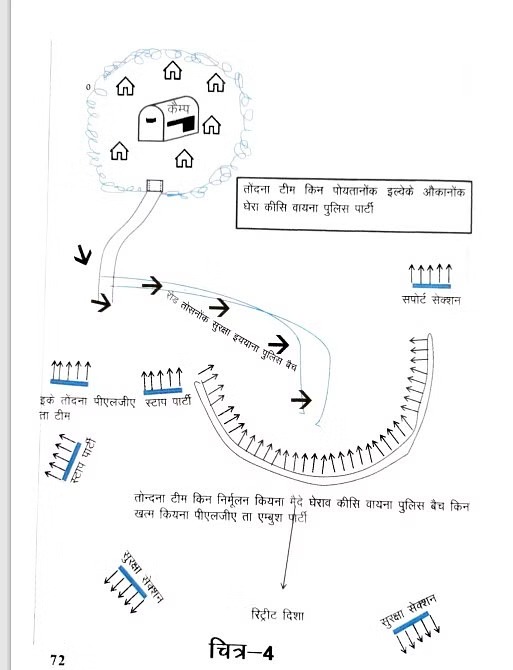
The insurgents also acknowledge past instances when drone surveillance “revealed the location of our ambush party to the police”, which, armed with intelligence inputs, fired “mortars on us and the ambush fizzled out”.
However, except the death of a woman cadre named Pottam Hungi in January, the Maoists have not admitted to any casualty in such attacks. The forces have not made any such claim either.
The Naxals have been developing indigenous propellers and mortars for well over a decade now, and have hit aircraft on a few occasions, but this is perhaps the first instance of a detailed policy document against unmanned aerial vehicles (UAVs) and helicopters.
Elaborating their strategy, the Naxals say that since each police camp is now armed with drones, “we should prepare camouflage kits” to “avoid detection” and “hide behind trees” to ensure that bombs hit the woods and are rendered ineffective.
The most violent Naxal attacks take place during summers, like the ambush on a convoy of Congress leaders at Darbha on 25 May 2013, but this is also the period when a thin forest cover makes stealth movements difficult.
“The biggest challenge is during autumns and summers when we are easily detected by drones,” the Naxals say, adding that “while it’s easier to camouflage during rains, we must not believe that drones won’t attack us during rains.”
It is believed that the forces avoid monsoon for operations as rivers of Bastar overflow and forested tracts become arduous. The Naxals are now cautioning their cadres to remain on guard during the rains as well.
The Print sent a questionnaire about the Naxals’ preparedness to the Bastar Police and the Central Reserve Police Force (CRPF). “We are aware of the threat perception. Our forces are prepared to deal with it,” said Inspector General of Police (IGP) Bastar range Sundarraj P.
While an official response from the CRPF is awaited, a senior CRPF officer told ThePrint: “We don’t have the capability of drone attack. We have drones only for the purpose of surveillance.”
Expressing concern over the developments, Chhattisgarh’s former DGP R.K. Vij said: “These are new and serious entrants to their (Naxal) strategy. First, snipers can be very demotivating for the forces. It means non-alert sentries are no longer secure now. Areas around police camps need to be better guarded now. Second, their focus on hitting aircraft is alarming. If they are able to take proper positions, especially on hillocks, they can cause serious damage to aircraft.”
Aerial counter strategy
If one aspect is self-defence, the other is to damage aircraft, a strategy the document describes through several diagrams. Noting that bombs are dropped from relatively “lesser height”, the Naxal platoons are instructed to ensure “deployment of teams on hilltop to hit drones”, and use “1-2 metre-long pipe bombs to attack helicopters and drones”.
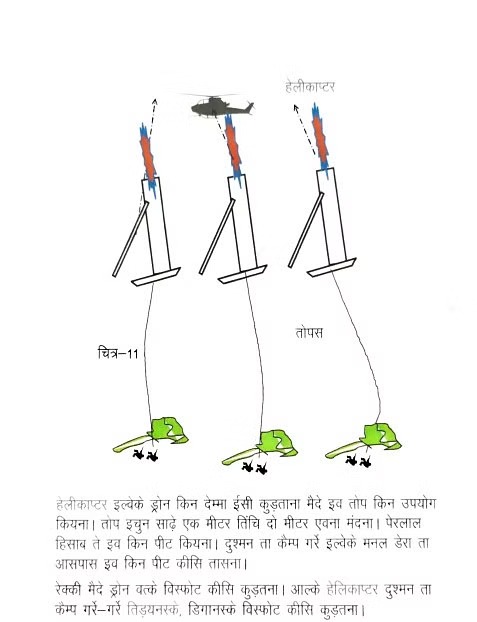
The Naxals also lay emphasis on special squads of snipers who are “extremely useful for attacking helicopters”.
“Place yourself on the ground and hit the blades or the fuel tank of the helicopter,” the document says, underlining that “snipers must use telescopes at night”, as well as bullets of specific dimensions to pierce the “aircraft’s strong metal covering”.
Over the last decade, the Naxals have targeted aircraft of security forces on a couple of occasions. An Indian Air Force (IAF) helicopter was hit by the Naxals in December 2011, while on an operational sortie in the interior forests of Sukma.
In January 2013, an Mi-17 had crash landed in Bastar after coming under insurgent fire. The Indian Air Force (IAF) crew abandoned the helicopter and rushed to a CRPF camp for safety, leaving behind Yem Lal Sahu, a wireless operator of the Chhattisgarh Police, who was injured in the attack.
While the air force had said that their crew left Sahu to “avoid a hostage situation”, the police had termed it “unfortunate” and “insensitive”. Doctors had said that “due to delay in treatment, Sahu developed haemodynamic instability that caused a paralytic attack”.
Sniper squads
The biggest focus seems to be on raising and strengthening sniper squads. The Naxals have had a variety of military units in the past — battalions, platoons, local guerrilla squads, quick action teams. Snipers seem to be a new entrant to their ranks.
Armed with precise rifles, snipers are lone-wolf hunters operating in stealth. Since ambushes by Naxal teams are becoming difficult, they are training individuals to launch attacks from hilltops, trees and bunkers. Snipers have proved crucial in battle fronts and their significance in jungle warfare cannot be overlooked.
“By sniper assaults, we can kill one police personnel a day and create fear in their ranks,” the document says, underlining that “if we are able to create such fear,” the forces will be “apprehensive about coming out of their camps”.
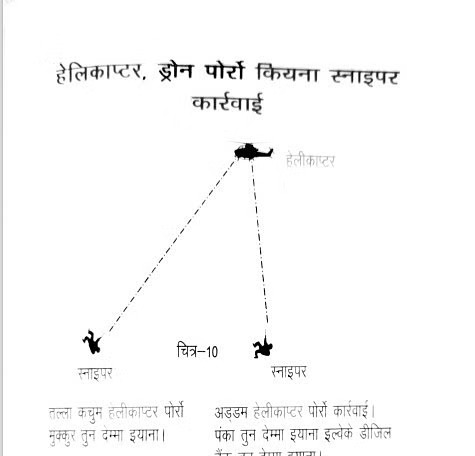
The document also suggests that the training of snipers has met with little success so far. “The sniper comrades lack fitness, hard work and planning. They should practice it daily or at least 2-3 times a week,” the document says.
Dealing with ‘carpet security’
The Naxals are also concerned about the increased deployment of forces and new camps in Bastar. “Forces have surrounded us from all sides. They are marching in heavy numbers,” the document says, noting that these new camps in distant forests “allow the forces to launch an instant attack on us”.
“Because of carpet security, we are not getting opportunities for even minor assaults. At times, our ambushes get exposed too early.”
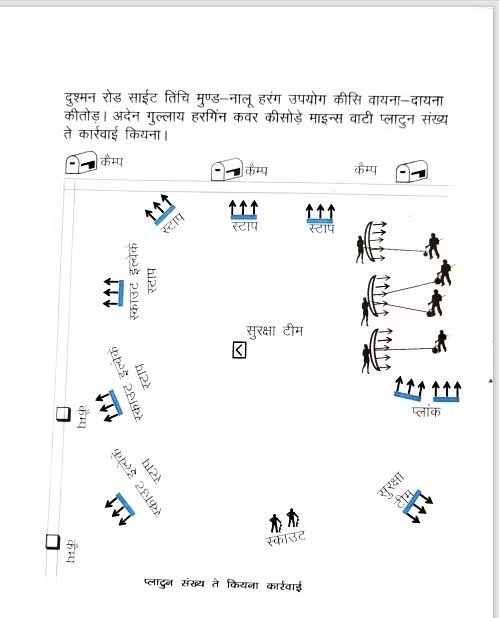
Through vivid pictorial representations, the Naxals have laid down protocols to attack a place laden with security camps: train the cadres for “launching rockets from trees” and ambush camps from multiple sides. The images suggest that the Naxals are preparing for simultaneous attacks on as many as six camps hosting several hundred security personnel.
Circulated among Naxal rank and file, the strategy document is now part of their training camps.



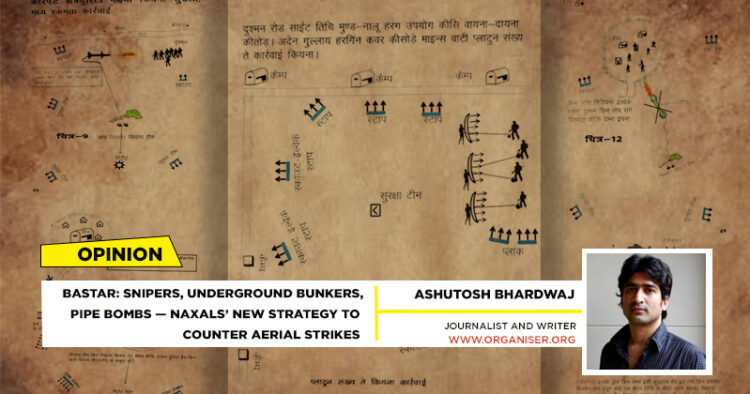















Comments